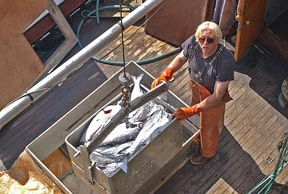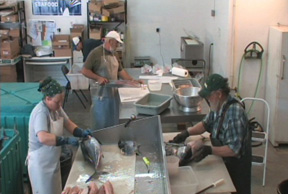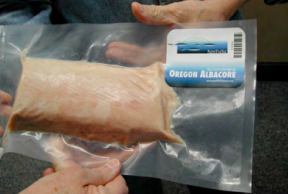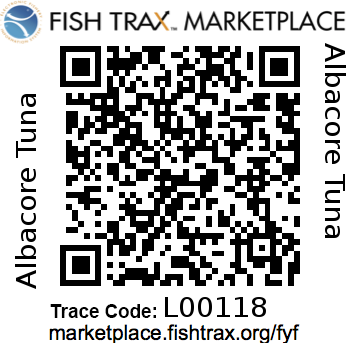The Market Place
Many Ways to Market
There are several ways that ocean-caught fish make their way to the market place:

Straight from the boat to the consumer. Some fishermen sell their catch, like salmon, albacore tuna or Dungeness crab, directly to the public. They sell right off their fishing vessels while moored at the dock. The fisherman sells the fish just as it was caught or sometimes fillets it on the deck of the boat for the buyer.

Straight from the boat to the retailer. Some fishermen sell their catch straight to fish markets or restaurants or other venues. This activity is usually termed “direct-marketing”. Generally seafood which requires a minimal amount of processing services or no processing at all are ideal candidates for direct-marketing scenarios.

The traditional channel. While a good portion of seafood caught is sold through direct-marketing avenues, the majority of all seafood landed on the west coast is delivered to some type of traditional seafood processing company. Many of these companies can be found in most fishing ports. On the west coast the majority of all seafood processors (large and small) are multi-generational, family-owned businesses.
Adding Value with Information


Pacific Fish Trax seeks to add value to seafood for west coast harvesters and seafood processors. We do so by examining the traditional tracks to market as well as creating new and innovative ones.
In early 2009 Pacific Fish Trax implemented a pilot study with a unique tracking system. The pilot program provided seafood purchasers with additional information about the seafood they were buying before they purchased the seafood. Two Portland-area New Seasons seafood departments participated in the pilot program by hosting two unique computer kiosks attached to freezers. The freezers contained high-quality frozen albacore tuna loins branded with the Pacific Fish Trax logo. The purchasers simply selected a package of fish and scanned the barcode on the reader located on the kiosk. The computer screen displays an informational video about the piece of fish the consumer was holding, including the name of the fisherman and vessel that caught the fish as well as the seafood processor who processed the fish once it reached the dock. We received a lot of great feedback and media coverage from this pilot, which you can read about in the final report from the project.
News Coverage of the Project
What Customers See (sample)
Connecting Seafood Consumers to Fishermen
 Sample QR Code Label
Sample QR Code Label
Building on the success of the prototype kiosk and the Fish Trax data visualization portals, Fish Trax Systems, Inc. began developing a new traceability and marketing platform in late 2012. Fish Trax Marketplace launched in 2013 in a number restaurants in the Gulf of Mexico. Restaurants and markets which use the Fish Trax Marketplace system provide customers a QR code along with their food. The QR code can be scanned using a smartphone, tablet, or PC to find out information about the fish they ate including where it was caught, which fisherman and vessel it was caught by, and where it was processed. This means that information is accessible whenever and wherever customers need it, and can be dynamically updated to deliver additional content such as recommendations for species that are in season, nutrition information, or recipe suggestions.
As Fish Trax Marketplace expands to include more fisheries and areas, we're finding new ways to use it to deliver valuable information to seafood consumers and providers alike. We're also keeping our eyes on the horizon of emerging technologies so that we can continue innovating with the next generation of fishery information systems!
